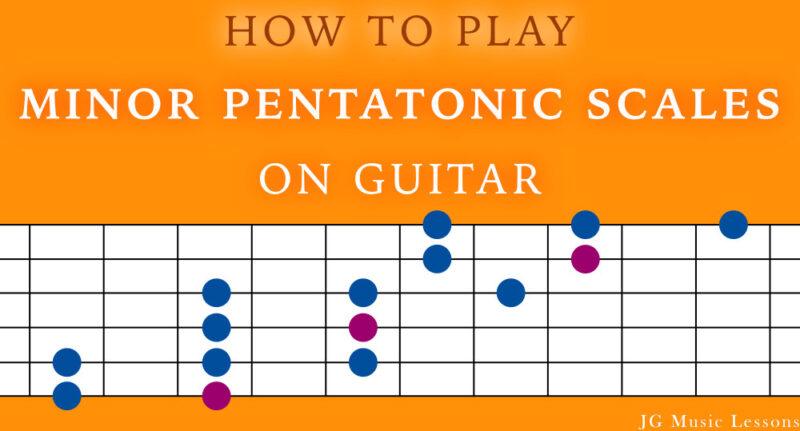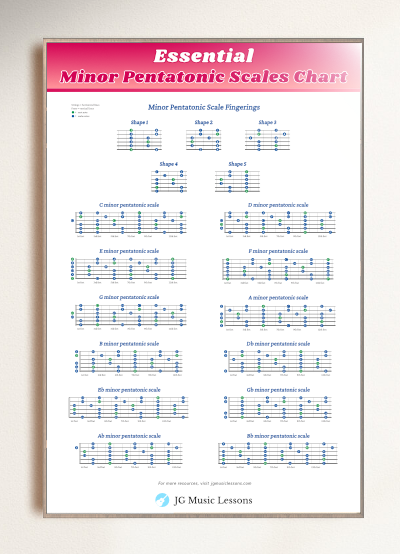The minor pentatonic is a dynamic 5 note scale which you’ve probably heard in multiple songs across different genres. It is one of the essential guitar scales to get better at improvisation because of its versatility and unique sound that can make your playing stand out.
In this lesson, we cover the five minor pentatonic scale shapes, how to connect them throughout the fretboard, and patterns you can use to take your improvisation to the next level.
This lesson will include guitar tabs and audio to help you learn the material much easier.
Grab your guitar and let’s get started!
Minor pentatonic scale formula
Let’s first go over some basic music theory behind the minor pentatonic scale before learning the shapes. The 5 scale notes in the minor pentatonic scale are the root, flat 3rd, 4th, 5th, and flat 7th scale degrees. You can think of these as notes which come from the minor scale.
The following formula shows you the distance between each note of the scale. You can use this formula to start on any root note. Whole steps are abbreviated to ‘w’.

All minor pentatonic scales use this same formula (1.5w, w, w, 1.5w, w). For example, using this formula, an A minor pentatonic scale has the notes A, C, D, E, and G.
Minor pentatonic scale chart in all keys
The following chart shows what notes belong the minor pentatonic scale starting on all 12 root notes.
| Minor pentatonic scale | 1 | b3 | 4 | 5 | b7 |
|---|---|---|---|---|---|
| C minor pentatonic scale | C | Eb | F | G | Bb |
| D minor pentatonic scale | D | F | G | A | C |
| E minor pentatonic scale | E | G | A | B | D |
| F minor pentatonic scale | F | Ab | Bb | C | Eb |
| G minor pentatonic scale | G | Bb | C | D | F |
| A minor pentatonic scale | A | C | D | E | G |
| B minor pentatonic scale | B | D | E | F# | A |
| Db minor pentatonic scale | Db | E | Gb | Ab | B |
| Eb minor pentatonic scale | Eb | Gb | Ab | Bb | Db |
| Gb minor pentatonic scale | Gb | A | B | Db | E |
| Ab minor pentatonic scale | Ab | B | Db | Eb | Gb |
| Bb minor pentatonic scale | Bb | Db | Eb | F | Ab |
Relation to the Major pentatonic
Did you know that the Major and minor pentatonic scales are related to each other? By starting on the second note of the minor pentatonic scale you actually play the same notes of the Major pentatonic scale.
For example, an A minor pentatonic scale has the same notes as a C Major pentatonic scale. Another example, an E minor pentatonic scale contains the same notes as the G Major pentatonic scale.
As a side note, the formula for the Major pentatonic scale includes these degrees: 1, 2, 3, 5, and 6. All we’re doing is shifting the way you look at the starting point.

You can also check out this other lesson for an overview of both Major and minor pentatonic scales.
When can you use the minor pentatonic scale?
The minor pentatonic scale can be used anywhere you would play a minor scale. For example, try an A minor pentatonic scale where you would normally play an A minor scale. You can think of the minor pentatonic scale as the minor scale without the 2nd, and 6th degrees. ‘H’ represents half steps between two notes.
You can compare these two scales in the formulas below.

Minor pentatonic scale shapes
Since the notes of a scale repeat in several areas of the guitar fretboard, we need to learn the minor pentatonic scale in five different shapes. Learning the following shapes gives us the flexibility to play the scale anywhere on the fretboard.
You can think of these as positions but since they will be shifted depending on what key you are playing, I prefer to think of them as movable shapes instead. Each shape is written in consecutive order so you can continue playing the scale as you move up the fretboard.
You can use any root note to play these shapes. After looking at these shapes, we’ll cover scale application examples in different keys.
How to read the scale charts
For the charts below:
- The lowest horizontal line represents the thickest string (Low E). The top horizontal line represents the thinnest string (high E).
- The purple circles represent the root note of the minor pentatonic scale and the blue notes are every scale note in between.
- The numbers inside the circles represent the suggested fingering to use on your fretting hand.
If needed, check out how to read guitar notation symbols.
Shape 1
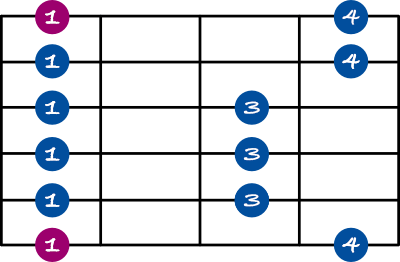
Shape 2
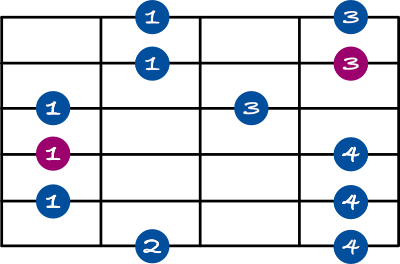
Shape 3
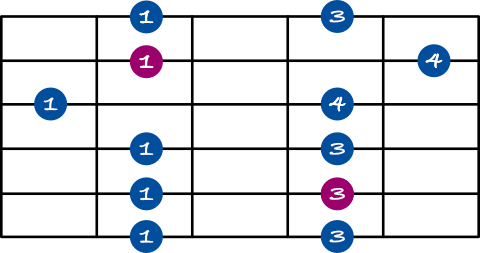
Shape 4
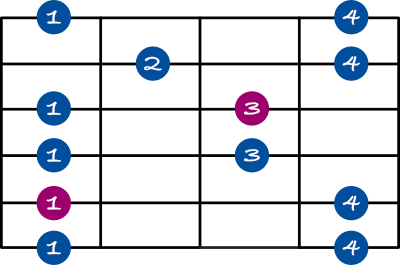
Shape 5
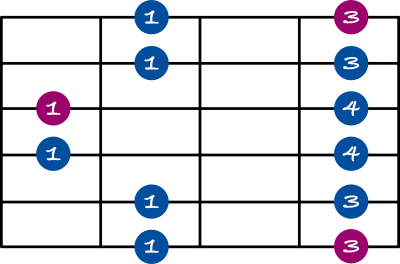
One thing to note about using these shapes is that whenever you have scales that use notes with open strings, you have to rearrange your fingers to play the shape. For example, if the shape uses the fingering 1 and 4 on one string, you can play (open string) and 3 instead.
Although you will need to change some fingerings if you include open strings, once you move over to the next shape where you’re fretting all the notes, you will get back to the original shapes we covered.
Minor pentatonic scale examples
In this section we’ll apply the five pentatonic scale shapes to different keys including audio files. I highly recommend you learn the notes on the fretboard to be able to shift the scale shapes to any key.
Note that these examples will not all start on the root note so that you can practice learning different scale shapes.
E minor pentatonic scale
This first example of the E minor pentatonic scale follows scale shape 1 but the fingering is adjusted because of the open strings. As mentioned earlier, if you use open strings, fingering 1 and 4 would become 0 and 3.

C minor pentatonic scale
This example also follows shape 1 and now includes all fretted notes which we saw in the original shape 1 chart.

G minor pentatonic scale
This is an example of a G minor pentatonic scale using shape 2.

D minor pentatonic scale
This is a D minor pentatonic scale using shape 3.

F minor pentatonic scale
This is an F minor pentatonic scale using shape 4.

A minor pentatonic scale
This is an A minor pentatonic scale using shape 5.

Minor pentatonic scale patterns
These patterns are different ideas that you can use to practice the minor pentatonic scales after learning the shapes. These pentatonic patterns can help you explore ways to make the scale sound more musical as opposed to just playing up or down the scale.
These examples will be based on shape 1 of the A minor pentatonic scale.
Consecutive 3 note pattern

Consecutive 4 note pattern
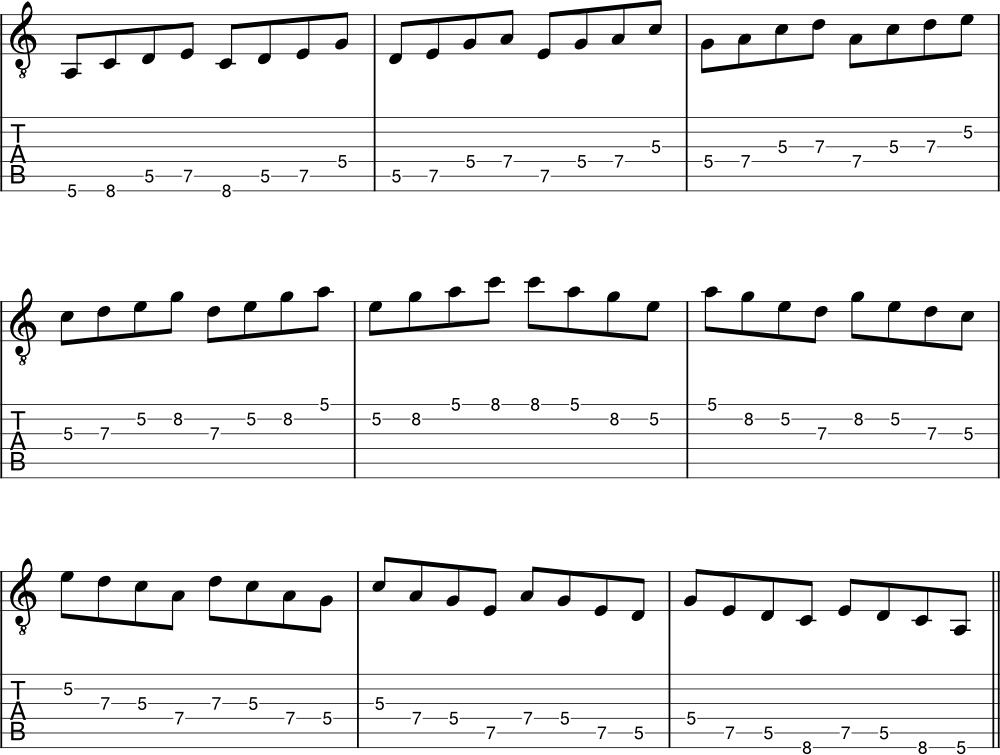
Consecutive 5 note pattern
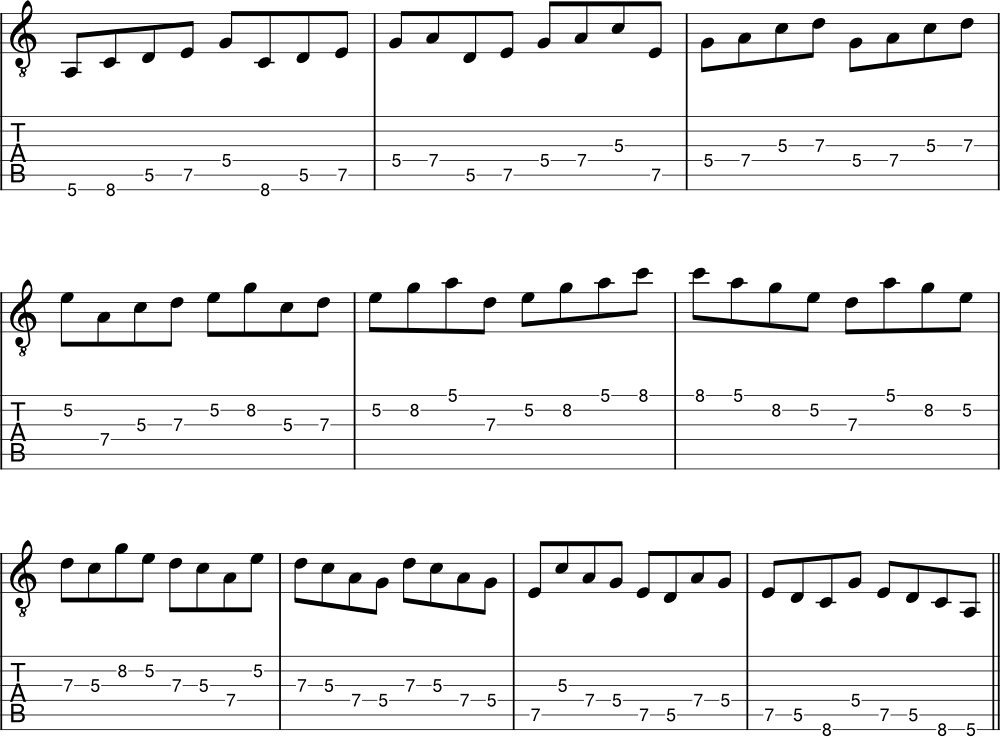
String skipping pattern

Connecting minor pentatonic scale shapes
After learning the 5 scale shapes, we also want to be able to connect them throughout the fretboard.
This section gives you some ideas of how you can connect the shapes we covered using repeating patterns with similar fingerings.
Again, you can choose any root note for these connecting shapes wherever it’s applicable to fit these on your fretboard, and always adjust fingerings and notes if you are using open strings.
Minor pentatonic connecting shape 1

Here is an example of the connecting shape 1 using the A minor pentatonic scale.

Minor pentatonic connecting shape 2

Here is an example of the connecting shape 2 for an E minor pentatonic scale.

3 tips for memorizing the minor pentatonic scale shapes
1. Master one shape at a time
The way I recommend learning and memorizing these scales is to start memorizing one shape that feels most comfortable for you. Try to really get the shape under your fingers to the point of not having to look at the chart. Use the first shape you master as a guide to learn the other scale shapes around it.
2. Look for repeating fingering patterns
Try to think of patterns such as what strings repeat the same fingering within a shape. For example, if a certain string set has a pattern of 1, 3, and 4, which other strings follow the same pattern? Or think of which strings only include 2 notes within a shape.
Quick tip: The notes on the first and sixth string will always be the same.
Knowing where note patterns repeat will help you build a mental map of a scale shape.
3. Connect shapes around the ones you learned
After getting one of the shapes down really well, either learn the shape that comes before or after it to see how the scale connects on the fretboard. Again, try to master one shape at a time and make sure you can play it without looking at the chart. This will make the process more approachable by breaking it down into smaller sections before moving on to the next shape.
Bonus: Minor blues scale formula
If you want to make the minor pentatonic scale sound more bluesy, you can simply add one half step note in between the 4th and 5th degree to play a minor blues scale.
The formula for a minor blues scale is 1, b3, 4, #4, 5, and b7.

For example, the A minor blues scale includes the notes A, C, D, D#, E and G.
To learn about this scale more in-depth, check out this lesson on how to play the blues scale on guitar.
Wrapping up
The minor pentatonic scale is a dynamic and versatile improvisational tool that can be used across a variety of musical genres. Once you learn the five scale shapes, it becomes easier to connect the notes of the minor pentatonic scale across the fretboard as well as being able to play it in different keys.
I recommend practicing your scales over a backing track if possible. This can help you to hear the character of each note and learn what notes you may want to highlight in your improvisation.
To learn more, check out these 9 tips to get better at improvising on guitar.
📘 Get the free guitar practice guide here!
All the best,
JG Music Lessons
📙 Kickstart your guitar playing with our step by step guide: Guitar Essentials.
🎸 Looking for a travel or half-sized guitar? See this one.
🛠 See our other music recommendations.
🤝 Support the site to help us to create better content for you!
Level up with the FREE guitar practice guide and effectively improve your playing! 🎸
Get it sent to your email!

